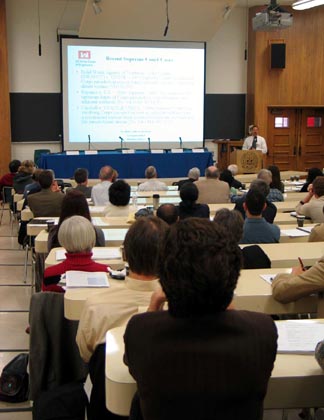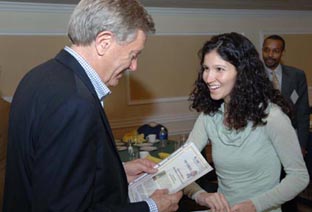Through a partnership with the UCLA School of Law, Planetizen Correspondent Lainie Herrera covered this engaging, interdisciplinary symposium featuring keynote speaker Bruce Babbitt, former Secretary of the Interior and Planetizen Top 10 Book award winner.

Written by Planetizen Correspondent Lainie Herrera
On Friday, April 7, 2006, lawyers, planners, geologists, geographers, government representatives, and students joined the 2006 Frankel Symposium at the UCLA School of Law to discuss "Preventing and Responding to Catastrophe: The Role of Environmental Law and Policy." The goal of the Frankel Symposium, produced by the UCLA School of Law's Evan Frankel Environmental Law & Policy Programand endowed by the Evan Frankel Foundation, was to foster an interdisciplinary discussion on environmental issues, particularly relating to natural catastrophe and disaster.

The 2006 Frankel Symposium begins.
The day's agenda included three panel discussions and lunch with keynote speaker Bruce Babbitt, former U.S. Secretary of the Interior and author of Cities in the Wilderness: A New Vision of Land Use in America, one of Planetizen's Top 10 Books published in 2005 (reviewed here). Panel discussions included "Natural Catastrophe and Human Nature," "Wetlands and Floodplains in Catastrophe Planning," and "Legal Scholars' Perspectives on Environmental Law and Catastrophe," and featured a variety of panelists with backgrounds in geography, non-profit activism, sociology, planning, engineering, geology, water resources, and law. The first discussion addressed the potential for future natural catastrophe, primarily in the United States, and who would most likely be affected by such disasters. Glen MacDonald of the UCLA Department of Geography emphasized the possibility of drought in arid regions of the United States, particularly as global warming continues to become more evident, and considered the systems we currently have to accommodate drought. "We as a society need to learn not to rush to the other side of the boat," said Kenneth Topping, a former Planning Director of the City of Los Angeles, citing the U.S. response to 9/11, which allocated resources to national security at the expense of other areas. This sentiment was echoed by MacDonald, who noted that society tends to plan for disaster and catastrophe directly after one has occurred -- that is, we are most prepared for the last catastrophe, but not necessarily for the next one.
The second panel focused on one of the most likely disasters to affect California -- failure of the San Joaquin-Sacramento Delta. The Delta provides approximately 25 percent of Southern California's water -- including agricultural irrigation and metropolitan drinking water -- and failure of the Delta's levees would be devastating to the entire state. Jeffrey Mountof the UC Davis Department of Geology warned attendees of this potential, perhaps impending, disaster. If the levees fail, not only will thousands of residents be impacted by flooding, the Delta will suck salt water in from San Francisco Bay, thus contaminating all the viable fresh drinking water the Delta provides.

Bruce Babbitt addresses the symposium.
The warnings of impending disaster were plentiful on Friday, but a consensus on the most effective way of addressing the problem seemed impossible to reach. Many of the attendees were anxious to hear Babbitt's lunchtime address, perhaps hoping that the former Governor of Arizona and Secretary of the Interior under President Clinton could offer some viable solutions. In his address, Babbitt focused on Hurricane Katrina and its aftermath and recovery, noting that New Orleans can be rebuilt "but it has to be conceived as an island" and "we can't fix [New Orleans] with Category 3 levees." Babbitt cited Florida's urban boundary line from Fort Lauderdale to Miami and preservation of the Florida Everglades as useful models for land use planning as preservation and disaster prevention. "Land use planning is the prerequisite," stated Babbitt, sharing a sentiment echoed by others throughout the day.
Babbitt talked with Planetizen about issues related to the planning field in particular. As President Bush's nomination to fill the Secretary of the Interior seat, Governor Dirk Kempthorne of Idaho, prepares for his nomination hearings, Babbitt offered his view of what the new Secretary's priorities should be: "to protect western lands and the Arctic Wildlife Refuge from reckless energy exploration and production," and to "support a strong revision of the Endangered Species Act." Beyond political leaders taking charge of land preservation issues, Babbitt is a strong proponent of land use planning as the best means of preservation, as well as disaster prevention. In his book, he emphasizes the important role of the federal government in land use planning, recognizing that this should not be achieved by restrictions on planning or development, but by applying "incentives for States and localities, using conditionality to protect open space."

Christopher Schroeder (Duke University School of Law) addresses moderator Jody Freeman (Harvard Law School).
The symposium closed with a panel discussing the legal venues for disaster response and planning. Questions and issues remained plentiful, while solutions were harder to come by. Douglas Kysar of Cornell Law School pointed out that the research used to establish precedent is debatable at best: why should levees in New Orleans be built to withstand Category 3 storms but not Category 5 storms? Ann Carlson of the UCLA School of Law presented the problem of heat waves in the U.S. and throughout the world, which kill more people per year than other natural disasters combined. She discussed potential reasons why heat waves are not often reported or responded to with the same level of urgency as other disasters, and discussed institutional responses and readiness. The panel noted that plans are key, although studies have shown that there is no correlation between a written disaster response plan and an institution's actual response.
The symposium succeeded in its goal of fostering an interdisciplinary discussion about catastrophe and natural disasters. As anticipated, the issue is more complicated than simply planning for disasters on a response level, because so many of society's daily activities compound the probability and scale of disasters we will experience in the future. Sean Hecht, Executive Director of the UCLA Environmental Law Center at UCLA School of Law, conceived of and directed the symposium, and summarized the outcome:

Planetizen Correspondent Lainie Herrera presents Bruce Babbitt with his Planetizen Top 10 Book Award certificate.
"One of the major lessons of the day, amplified by Secretary Babbitt, is the need for sound planning to ensure that housing doesn’t continue to be built in places where catastrophe is likely to jeopardize communities. Another important lesson is that efforts to fix our levee system in Sacramento will not solve the root problems that lead to dire environmental consequences, but will only buy us time. Finally, it is clear that low-income communities will suffer the most whenever disaster strikes, and we must work harder to make sure that our most vulnerable residents are better protected. Overall, I think people gained a lot of perspective on some of our most pressing problems, and anticipate that more important work will follow out of this conference."
As Kenneth Topping tells us, "it's imperative that planners have [disasters] in the back of their minds" as they make plans on community, city, and regional levels.
Lainie Herrera is a Senior Environmental Planner at Christopher A. Joseph & Associates, an environmental consulting firm specializing in the management and preparation of environmental documents. When not thinking about urban planning or the environment she reads fiction.
Thanks to Sean Hecht, Executive Director of the Environmental Law Center at UCLA School of Law, and Philip Little, Director of Communications for the UCLA School of Law, for their help coordinating coverage of this event.
The UCLA School of Law's Evan Frankel Environmental Law and Policy Program
The UCLA School of Law's Evan Frankel Environmental Law and Policy Program is dedicated to fostering informed analysis of timely and important issues involving governance and regulation in environmental policy. The Program convenes experts, advocates and policymakers in large public forums like the symposium, as well as in smaller stakeholder meetings and roundtable discussions. By bringing the right people together to discuss important issues, the Program is able to help to identify solutions as well as important topics for collaborative research. The Program is purposefully interdisciplinary, drawing on expertise from many fields, since virtually all problems relating to land use, natural resources and the environment require solutions that incorporate work in law, social sciences, planning, the natural sciences, and public policy. Past program topics have included California's efforts to regulate greenhouse gases, air pollution in microenvironments and its implications for land use, and siting of liquefied natural gas importation facilities. The Program has also sponsored original research, including a paper analyzing the impacts of environmental regulation (the California Environmental Quality Act (CEQA) in particular) on affordable housing.

Maui's Vacation Rental Debate Turns Ugly
Verbal attacks, misinformation campaigns and fistfights plague a high-stakes debate to convert thousands of vacation rentals into long-term housing.

Planetizen Federal Action Tracker
A weekly monitor of how Trump’s orders and actions are impacting planners and planning in America.

In Urban Planning, AI Prompting Could be the New Design Thinking
Creativity has long been key to great urban design. What if we see AI as our new creative partner?

Massachusetts Budget Helps Close MBTA Budget Gap
The budget signed by Gov. Maura Healey includes $470 million in MBTA funding for the next fiscal year.

Milwaukee Launches Vision Zero Plan
Seven years after the city signed its Complete Streets Policy, the city is doubling down on its efforts to eliminate traffic deaths.

Portland Raises Parking Fees to Pay for Street Maintenance
The city is struggling to bridge a massive budget gap at the Bureau of Transportation, which largely depleted its reserves during the Civd-19 pandemic.
Urban Design for Planners 1: Software Tools
This six-course series explores essential urban design concepts using open source software and equips planners with the tools they need to participate fully in the urban design process.
Planning for Universal Design
Learn the tools for implementing Universal Design in planning regulations.
Gallatin County Department of Planning & Community Development
Heyer Gruel & Associates PA
JM Goldson LLC
City of Camden Redevelopment Agency
City of Astoria
Transportation Research & Education Center (TREC) at Portland State University
Jefferson Parish Government
Camden Redevelopment Agency
City of Claremont


























